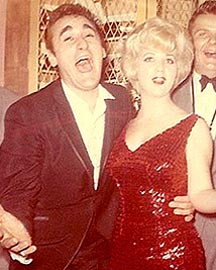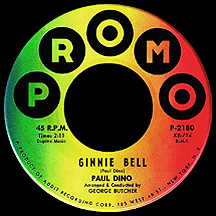PAUL DINO
Ginnie Bell
It was young romance on display every day from coast to coast during the late 1950s and early '60s on American Bandstand. Justine Carrelli and Bob Clayton were dancing partners on Dick Clark's not-to-be-missed daily Philadelphia-based dancefest and stop for popular singers. They spent a few years together on camera and let it be known they were "going steady." But the two didn't end up together. A local singer with a hit record appeared one day on the show, in the snow, and won Justine's heart!
At one point, Paul Dino Bertuccini had decided to become a barber. In the late '50s he started a band called The Nite Caps, adopted the shortened professional name Paul Dino, and before long the job of singing an assortment of songs in nightclubs won out over warbling "Shave and a Haircut" a couple dozen times a day. Paul had learned to play several instruments during high school including piano, saxophone and drums; he even became quite the accordion assimilator. No word on whether he was ever proficient with a pair of scissors. Songwriting was a passion as well and he began making regular excursions into New York City to knock on the doors of the various music publishing houses. He made overtures to some of the record labels too, but they didn't seem interested. After more than a year of attempts, he got his foot in the door at a very small company putting out records on the Addit and Promo labels.
Bill Lasley had been in the record business for several years, scoring with The Danleers ("One Summer Night") in 1958 while he was running the short-lived Amp 3 label. Working for Addit/Promo in '60, which had recently racked up a top ten hit with the Promo single "A Million to One" by Jimmy Charles, he granted Dino enough time for a quick audition and decided to give him a shot. Struggling R&B producer George Butcher was hired to oversee the session. Dino recorded three songs he had written, but they wanted a fourth. An impromptu jam session commenced with the guitarist launching into a standard Bo Diddley beat while Dino made up a song as he went along, mostly singing 'Ginnie Bell, la-la-la-la-lalalala' as the female backing group chimed in with 'Hey, Miss Ginnie Bell,' his vocals at the song's fade going even further into scatlike nonsense syllables too mangled to attempt transcribing. The result was just great; absolute off-the-cuff madness.
Butcher liked what he heard, so Dino offered to do a few more takes and polish up the sound. He was told it was fine as it was and the session ended. He hopped a Greyhound, the only means of transportation he could afford at the time, back to Philly. "Ginnie Bell" was released in December 1960 (the label ran large ads in Billboard, mistakenly printing the title as "Ginny Bell"). Dino was disillusioned by it all. Why would anyone prefer a quickly thrown together, throwaway tune over the three he'd worked so hard to prepare? But the Promo honchos had ears for the teenage market; "Ginnie" and its flip, "Bye-Bye," are fabulous teen tunes and the impromptu A side went on to hit the top 40 in April '61.
Paul appeared on Bandstand as the single was climbing the charts. A snow storm had hit and on that particular winter day, for fun, the show was broadcast outside the studio. Justine Carrelli was there, having been a regular for about four years (not quite 14 when she started), popular with viewers as were a number of the regular dancers on the show. Some referred to her as a "blonde bombshell" and she was featured in many fan magazines of the time, including a 1958 issue of Photoplay with a layout from a party the magazine threw for her 16th birthday. She even made the cover of the March 1960 issue of 'Teen magazine. Not long afterward, Justine left the show and married Dino, dashing the dreams of her legion of Clearasil-dabbing male admirers.
There were no further hits for Paul Dino. Promo didn't even bother to issue a follow-up. About a year later Phil Spector, getting ready to bolt from his A&R position with Liberty Records, came across a song Dino had written, "Na-Ne-No" (more nonsense syllables!), producing and arranging it for singer Troy Shondell (the "This Time" guy) as the singer's third single (give this catchy song at least three listens and I guarantee you'll be humming it all day). It showed up on the "Bubbling Under" chart for a couple of weeks in June '62, a second appearance for Paul Dino somewhere on a national chart, at least.

By the time "Na-Ne-No" came out, Paul and Justine had moved to Las Vegas. The Paul Dino Group was a regular attraction at the Fremont Hotel (in those days the tallest building in Nevada) in its Carnival Room (where Wayne Newton had frequently appeared starting in 1959 while he was still in high school). Justine was a "featured performer," serving as a backup singer, also doing the twist and other current dances while Dino and the band lit up the lounge. His recording and songwriting career hadn't ended just yet, either; he hooked up with Jerry Leiber and Mike Stoller, who produced the summer '62 single "That's How I Miss You," a pure teen ballad on United Artists, his only record released by a major record company. "Goin' in Town" (actually 'Goin' TO Town' in the song's lyrics) came out on the mysterious Flame label and "I Like Your Style" appeared in 1963 on another small label, Entré.
Once the Vegas lounge bookings ran their course, Paul Dino and his longtime love Justine stayed in the Gambling Capital. She had remained good friends with Dick Clark, seeing him socially with his wife Kari Wigton when they visited Las Vegas during the '70s and '80s. "Ginnie Bell" was a distant memory, nonexistent on oldies stations and of interest only to diehard collectors and obsessive music fans like myself. The couple ventured into a new line of work: real estate. Nice timing, as the city's population boom was on the horizon.


